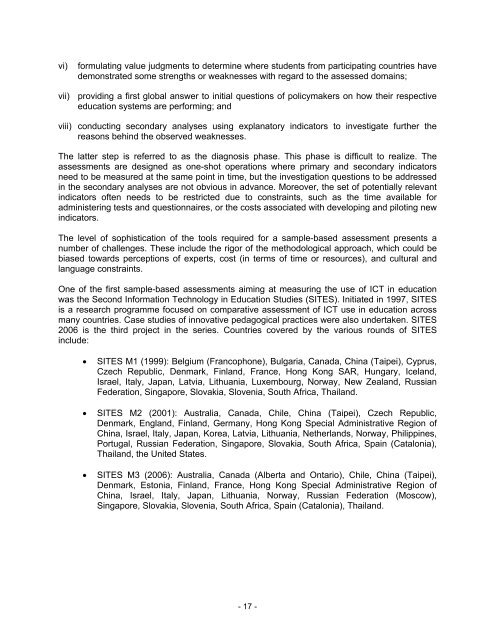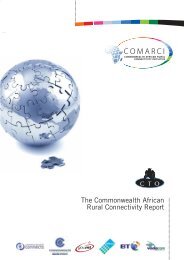Guide to measuring information and ... - unesdoc - Unesco
Guide to measuring information and ... - unesdoc - Unesco
Guide to measuring information and ... - unesdoc - Unesco
Create successful ePaper yourself
Turn your PDF publications into a flip-book with our unique Google optimized e-Paper software.
vi) formulating value judgments <strong>to</strong> determine where students from participating countries have<br />
demonstrated some strengths or weaknesses with regard <strong>to</strong> the assessed domains;<br />
vii) providing a first global answer <strong>to</strong> initial questions of policymakers on how their respective<br />
education systems are performing; <strong>and</strong><br />
viii) conducting secondary analyses using explana<strong>to</strong>ry indica<strong>to</strong>rs <strong>to</strong> investigate further the<br />
reasons behind the observed weaknesses.<br />
The latter step is referred <strong>to</strong> as the diagnosis phase. This phase is difficult <strong>to</strong> realize. The<br />
assessments are designed as one-shot operations where primary <strong>and</strong> secondary indica<strong>to</strong>rs<br />
need <strong>to</strong> be measured at the same point in time, but the investigation questions <strong>to</strong> be addressed<br />
in the secondary analyses are not obvious in advance. Moreover, the set of potentially relevant<br />
indica<strong>to</strong>rs often needs <strong>to</strong> be restricted due <strong>to</strong> constraints, such as the time available for<br />
administering tests <strong>and</strong> questionnaires, or the costs associated with developing <strong>and</strong> piloting new<br />
indica<strong>to</strong>rs.<br />
The level of sophistication of the <strong>to</strong>ols required for a sample-based assessment presents a<br />
number of challenges. These include the rigor of the methodological approach, which could be<br />
biased <strong>to</strong>wards perceptions of experts, cost (in terms of time or resources), <strong>and</strong> cultural <strong>and</strong><br />
language constraints.<br />
One of the first sample-based assessments aiming at <strong>measuring</strong> the use of ICT in education<br />
was the Second Information Technology in Education Studies (SITES). Initiated in 1997, SITES<br />
is a research programme focused on comparative assessment of ICT use in education across<br />
many countries. Case studies of innovative pedagogical practices were also undertaken. SITES<br />
2006 is the third project in the series. Countries covered by the various rounds of SITES<br />
include:<br />
SITES M1 (1999): Belgium (Francophone), Bulgaria, Canada, China (Taipei), Cyprus,<br />
Czech Republic, Denmark, Finl<strong>and</strong>, France, Hong Kong SAR, Hungary, Icel<strong>and</strong>,<br />
Israel, Italy, Japan, Latvia, Lithuania, Luxembourg, Norway, New Zeal<strong>and</strong>, Russian<br />
Federation, Singapore, Slovakia, Slovenia, South Africa, Thail<strong>and</strong>.<br />
SITES M2 (2001): Australia, Canada, Chile, China (Taipei), Czech Republic,<br />
Denmark, Engl<strong>and</strong>, Finl<strong>and</strong>, Germany, Hong Kong Special Administrative Region of<br />
China, Israel, Italy, Japan, Korea, Latvia, Lithuania, Netherl<strong>and</strong>s, Norway, Philippines,<br />
Portugal, Russian Federation, Singapore, Slovakia, South Africa, Spain (Catalonia),<br />
Thail<strong>and</strong>, the United States.<br />
SITES M3 (2006): Australia, Canada (Alberta <strong>and</strong> Ontario), Chile, China (Taipei),<br />
Denmark, Es<strong>to</strong>nia, Finl<strong>and</strong>, France, Hong Kong Special Administrative Region of<br />
China, Israel, Italy, Japan, Lithuania, Norway, Russian Federation (Moscow),<br />
Singapore, Slovakia, Slovenia, South Africa, Spain (Catalonia), Thail<strong>and</strong>.<br />
- 17 -
















